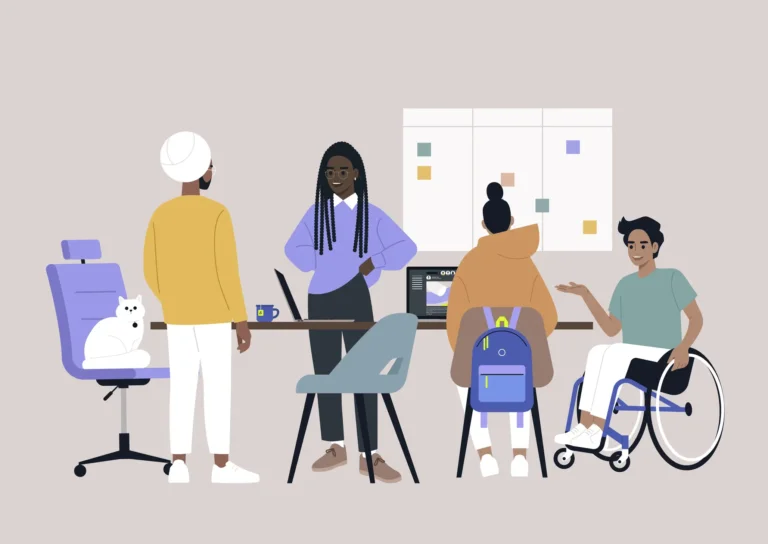An accessible B2B SaaS product is key to inclusive design

About 54 million Americans live with a disability of some type. Disabilities can range from something physical — such as blindness or deafness — to mental, which can affect the default ways people view and intake information.
These users may use software with the aid of technology like voice control or screen readers. But when a B2B product has an accessible design, people can more easily use assistive technologies and understand information. In fact, an accessible B2B SaaS product design means people of all abilities can work efficiently.
Why design accessibly?
Creating a product that does not take these users into account can push away a large group of potential customers. In the case of B2B SaaS, it may create friction between employees and employers because they may have trouble using a product that causes a tedious workflow.
There are also legal considerations. In the US, all federal agencies must follow Section 508 rules. Agencies must give disabled employees and members of the public access to infrmation comparable to the access for all others. Many states also have accessibility rules.
By not meeting these standards, companies can face hefty fines, as well as earn the frustration of users who cannot effectively use a software or website.
WCAG standards set a goal for robust baseline accessibility. by meeting and even exceeding accessibility standards, a B2B platform improves for all users, regardless of ability. This means a wider range of people who can use the software and more potential customers.
Understanding users’ abilities
It’s important to understand the more common ways that disabilities appear.
Disabilities can fall in these groups:
- Visual
- Hearing
- Cognitive or Neurological
- Physical
The nature of some disabilities means that there may be overlap. For example, a person with a neurological disorder, such as autism, may not only have a physical impairment, but may also take in visual information differently than an able-bodied person. That’s why it’s important to reduce cognitive overload — which can happen with too many bright and distracting visuals — while allowing for easily clickable or keyboard navigable interface.
Using a font size at least 14pt helps all people see text easier, not just those with vision difficulties. In fact, it’s best practice to use at least 14pt size font to reduce eye-strain, especially if your users are taking in a lot of information at once.
What to follow and how
The WCAG (Web Content Accessibility Guidelines) is a good checklist to see if a product is accessible. WCAG is developed through W3C (World Wide Web Consortium), which sets standards for the WAI (Web Accessibility Initiative).
The W3C is an international consortium and follows standards for accessibility constantly. Following WCAG AA 2.2 standards is a good way to ensure your products meets baseline ADA standards.
For software requiring more stringent guidelines to accessibility, use WCAG standards at its highest level (AAA). Essentially, the guidelines are themselves, easily accessible and available for general use.
How to ensure an accessible B2B SaaS product
ARIA Attributes
A common part of accessible development that often gets overlooked is ARIA (Accessible Rich Internet Applications Suite) attributes.
In web-technology developed products, ARIA attributes help define functionality of components for screen readers and keyboard functionality. By defining components and states — such as what is a “menu,” “readonly,” or a “checked” checkbox — screen readers can better understand what information is important to process and describe.
Keyboard functionality improves by identifying the most important information, rather than forcing the user to press tab over and over until they reach the menu.
Style and accessibility
It’s a misconception that accessible design is at odds with stylish design.
Many designs that appear chic and modern do not always adhere to AA or AAA standards of accessibility. In fact, designing only for style can hurt the product in the end by giving it an unstable and unusable foundation.
Good design works with accessibility standards, not against. UI design that incorporates accessibility standards is more stable and allows for expansion more easily. With standards built into the design system, scaling the product for future iterations is less a game of catching up the design with accessibility standards. That way you can focus on growth and improvement.
Inclusive design
Inclusive design is a process for creating design that can be used by a diverse group of people. When thinking about accessible design, it’s important to think about inclusive solutions rather than a universal one-size-fits-all approach. This may require feedback from people who are not just able-bodied and adding solutions based on their reported pain points.
For example, users who have to work harder to find transcripts or closed captions on video content will feel purposefully left out and excluded. By offering an equivalent experience with easy-to-find closed captions, a product can endear itself to its user base above competitors who do not.
It’s also important to note — people of all abilities use captions and transcripts. This is just another example of how meeting accessibility standards helps all people.
Now, implement an accessible B2B SaaS product!
A baseline of stable, compliant, stylish and convenient accessibility can be achieved by following expert guidelines and keeping in mind points that often get overlooked by the competition. Don’t shy away from asking for help from focus groups that can give vital feedback on what is still missing from the platform in terms of a good user experience.
When designing an accessible B2B SaaS product, you open the door for more users to function efficiently and have a positive experience navigating digital products.











